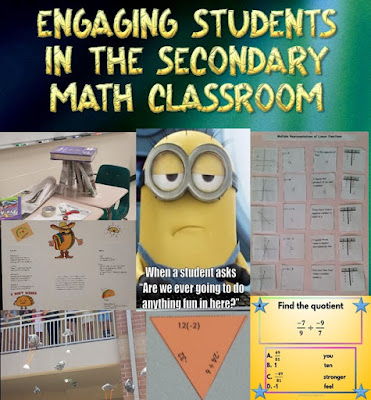We’ve
all heard the saying “You’ll never get a second chance to make a great first
impression”. That’s one of the reasons
teachers put so much time and effort into organizing, arranging, and decorating
their classrooms. We have a lot of
people to impress – students, parents, coworkers, administrators, and we want
to get it right. Doing it over when you
have not done it right in the first place?
Nobody’s got time for that, plus an opportunity wasted. But even a really great first impression can’t
save you in the day to day battle to teach math to teens and tweens. To put that into perspective, use the movie Fifty First Dates as your variable with
a coefficient of 3.6.
Here
are some tips for designing engaging lessons that have worked for me:
1.
The 10-15 Rule. Students have a short attention span. By switching things up every ten to fifteen
minutes, you have a better chance to keep and maintain their attention. Break your lessons into small chunks that
allow you to switch back and forth between you teaching and their doing. Make sure each class contains opportunities
for students to actively participate in their learning.
2.
Remember, the person doing the talking is the
person doing the learning. Yes, direct
instruction is very much needed in mathematics, but give the kids a chance to
talk too. Let them paraphrase to a
partner, create and solve a problem to exchange, have small group discussion
and presentations, etc. For review days
consider having small groups give 5-7 minute “mini lessons” to the class. Listening to my kids talk math is the
highlight of each and every day.
3.
Movement.
It’s hard to sit all day. Think
about how you feel during those endless faculty meetings and training
sessions. Use activities and resources
that get kids out of their seats and moving.
It’s much harder for them to fall asleep or zone out when they are
moving around. Scavenger hunts,
walk-abouts, relay games, and learning stations are all great options.
4.
Choice Menus.
Experiment with them for classwork, homework, and assessments. Student Choice = Student Buy-in. It’s a beautiful thing!
5.
Provide students with meaningful, relevant
feedback. We’re not talking grades
here. Students want to hear what we
think about their work, ideas, and effort.
Try to provide specific, targeted feedback to students rather than the
generic “good job”.
6.
Make it meaningful. Math is all around us in the real world. Show your students where it is and what it
means. Use technology like virtual field
trips and webquests to help students see the connections to what they are
learning and the world around them.
As
you transition to a more engaging classroom, remember you can’t do it
overnight. Set reasonable goals for
yourself. Maybe plan to include one
activity per week or use choice menus once a month. Try new things to find what works best for
you and your students. Get feedback from
students to get an idea of what they like and don’t like. Give yourself permission to fail. There will be truly excellent experiences and
truly horrible experiences when we move outside our comfort zones. If you start each class in a way that sets a
positive tone for learning, give students meaningful choices, set high
expectations and teach our kids how to meet them, your classroom will become an
engaging math community for you and your students.
Finally,
I’d like to share some of my favorite words of wisdom for educators:



No comments:
Post a Comment